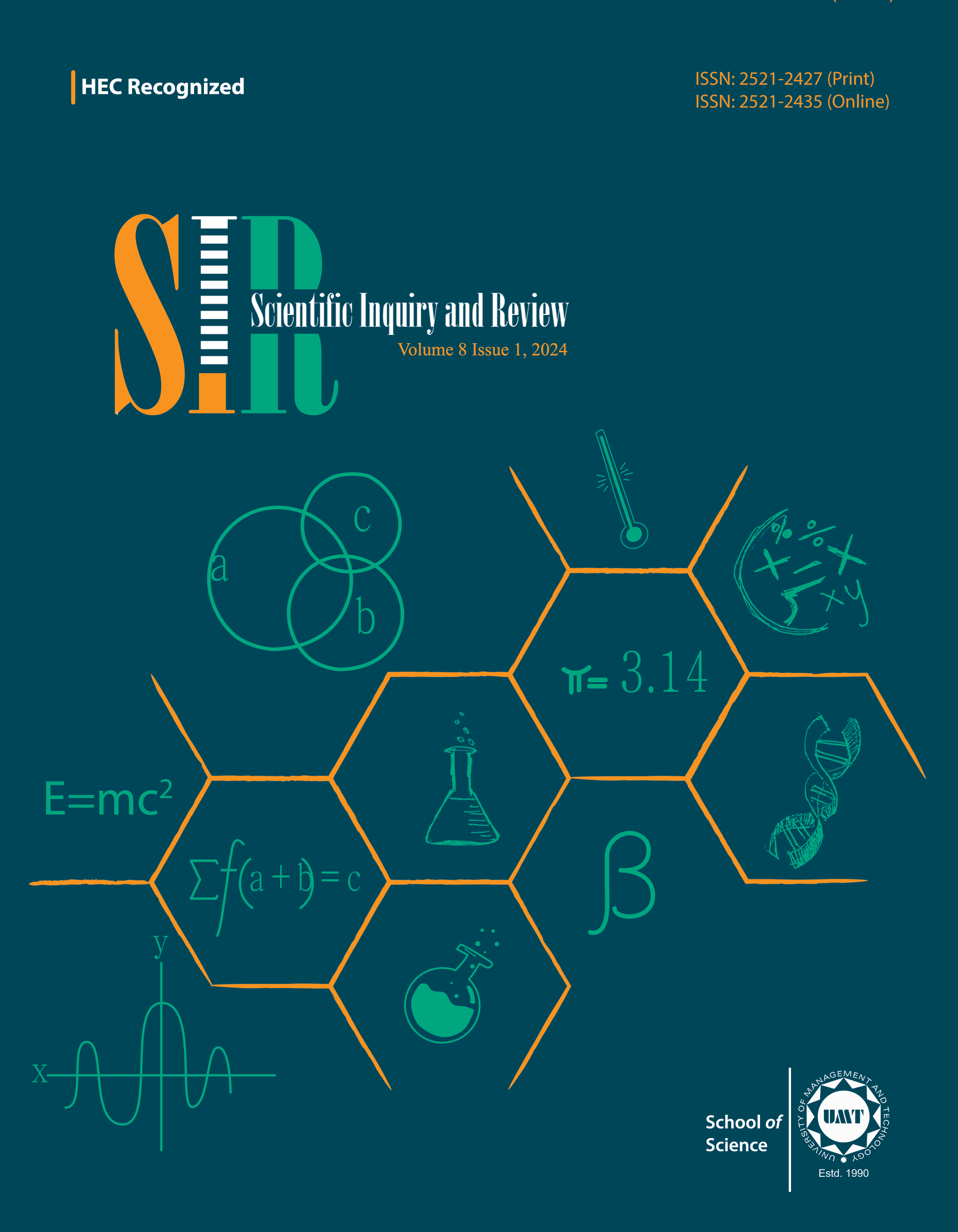Assessment of Total Aflatoxin Content in Dry Fruits Samples Collected from Local Markets of Lahore, Pakistan
Aflatoxins in dry fruits
Abstract
 Abstract Views: 0
Abstract Views: 0
This report presents an evaluation of the concentration of total aflatoxins in a range of dry fruits obtained from local markets in Lahore, Pakistan. It also proposes some risk mitigation strategies through detoxification. The analysis involved appropriate techniques to accurately quantify the total aflatoxin (AF) content in each sample. According to the findings, AFs were not found in any of the branded dry fruit samples. However, AFB1 contamination in open samples of almonds, peanuts, apricots, walnuts, raisins, figs, and coconut was found in concentrations exceeding the EU guidelines. Furthermore, dry fruit samples collected from branded companies showed no AF- contamination. These findings suggest potentially high health risks posed by using dry fruits from open markets. This fact further emphasizes the importance of detoxification methods for safer consumption.
Downloads
References
Huwig A, Freimund S, Käppeli O, Dutler H. Mycotoxin detoxication of animal feed by different adsorbents. Toxicol Lett. 2001;122(2):179–88. https://doi.org/10.1016/s0378-4274(01)00360-5
Qazi JI, Fayyaz Z. Aflatoxin contaminated foods and health risk perspective for Pakistani population. Mycopath. 2006;4(2):27–34.
Iqbal A, Khalil IA, Shah H. Aflatoxin contents of stored and artificially inoculated cereals and nuts. Food Chem. 2006;98(4):699–703. http://dx.doi.org/10.1016/j.foodchem.2005.06.034
Kabak B, Dobson AD, Var Il. Strategies to prevent mycotoxin contamination of food and animal feed: a review. Crit Rev Food Sci Nutr. 2006;46(8):593–619. https://doi.org/10.1080/10408390500436185
Juan C, Zinedine A, Molto J, Idrissi L, Manes J. Aflatoxins levels in dried fruits and nuts from Rabat-Salé area, Morocco. Food Control. 2008;19(9):849–53. https://doi.org/10.1016/j.foodcont.2007.08.010
Bhat R, Ramakrishna Y, Beedu S, Munshi K. Outbreak of trichothecene mycotoxicosis associated with consumption of mould-damaged wheat products in Kashmir Valley, India. Lancet. 1989;333(8628):35–37. https://doi.org/10.1016/S0140-6736(89)91684-X.
Gratz S, Wu Q, El-Nezami H, Juvonen R, Mykkänen H, Turner P. Lactobacillus rhamnosus strain GG reduces aflatoxin B1 transport, metabolism, and toxicity in Caco-2 cells. Appl Environ Microb. 2007;73(12):3958–3964. https://doi.org/10.1128/AEM.02944-06
Eslami M, Mashak Z, Heshmati A, Shokrzadeh M, Nejad ASM. Determination of aflatoxin B1 levels in Iranian rice by ELISA method. Toxin Rev. 2015;34(3):125–28. https://doi.org/10.3109/15569543.2015.1074925
Nejad ASM, Ghannad MS, Kamkar A. Determination of aflatoxin B1 levels in Iranian and Indian spices by ELISA method. Toxin Rev. 2014;33(4):151–54. https://doi.org/10.3109/15569543.2014.942319
Romer TR, Campbell AD. Collaborative study of a screening method for the detection of aflatoxins in mixed feeds, other agricultural products, and foods. J Assoc Off Anal Chem. 1976;59(1):110–117. https://doi.org/10.1093/jaoac/59.1.110
Romer TR. Screening method for the detection of aflatoxins in mixed feeds and other agricultural commodities with subsequent confirmation and quantitative measurement of aflatoxins in positive samples. J Assoc Off Anal Chem. 1975;58(3):500–506. https://doi.org/10.1093/jaoac/58.3.500
Nazir A, Asif M, Kalim I, Ahmad N, Iqbal M. Quantification of aflatoxins in dry fruits using ELISA with reference to standards for human consumption. Chem Intl. 2021;7(4):224–229.
Asghar MA, Ahmed A, Zahir E, Asghar MA, Iqbal J, Walker G. Incidence of aflatoxins contamination in dry fruits and edible nuts collected from Pakistan. Food Contl. 2017;78:169–175.
Phillips TD, Lemke SL, Grant PG. Characterization of clay-based enterosorbents for the prevention of aflatoxicosis. Adv Exp Med Biol. 2002:157–171. https://doi.org/10.1007/978-1-4615-0629-4_16
Tian J, Zeng X, Zeng H, Feng Z, Miao X, Peng X. Investigations on the antifungal effect of nerol against Aspergillus flavus causing food spoilage. Sci World J. 2013;2013:e230795. https://doi.org/10.1155/2013/230795
El-Aziz A, Abeer R, Mahmoud MA, Al-Othman MR, Al-Gahtani MF. Use of selected essential oils to control aflatoxin contaminated stored cashew and detection of aflatoxin biosynthesis gene. Sci World J. 2015;2015:e958192. https://doi.org/10.1155/2015/958192
Velazhahan R, Vijayanandraj S, Vijayasamundeeswari A, et al. Detoxification of aflatoxins by seed extracts of the medicinal plant, Trachyspermum ammi (L.) Sprague ex Turrill–structural analysis and biological toxicity of degradation product of aflatoxin G1. Food Cnt. 2010;21(5):719–725. https://doi.org/10.1016/j.foodcont.2009.10.014
Karlovsky P, Suman M, Berthiller F, et al. Impact of food processing and detoxification treatments on mycotoxin contamination. Mycotoxin Res. 2016;32(4):179–205. https://doi.org/10.1007/s12550-016-0257-7
Rastegar H, Shoeibi S, Yazdanpanah H, et al. Removal of aflatoxin B1 by roasting with lemon juice and/or citric acid in contaminated pistachio nuts. Food Cont. 2017;71:279–284. https://doi.org/10.1016/j.foodcont.2016.06.045
Samarajeewa U, Sen A, Cohen M, Wei C. Detoxification of aflatoxins in foods and feeds by physical and chemical methods. J Food Prot. 1990;53(6):489–501. https://doi.org/10.4315/0362-028X-53.6.489
Masood M, Iqbal SZ, Asi MR, Malik N. Natural occurrence of aflatoxins in dry fruits and edible nuts. Food Contl. 2015;55:62–65. https://doi.org/10.1016/j.foodcont.2015.02.041
Luttfullah G, Hussain A. Studies on contamination level of aflatoxins in some dried fruits and nuts of Pakistan. Food Contl. 2011;22(3-4):426–429. https://doi.org/10.1016/j.foodcont.2010.09.015
Onyeaka H, Ghosh S, Obileke K, et al. Preventing chemical contaminants in food: Challenges and prospects for safe and sustainable food production. Food Contl. 2024;155:e110040. https://doi.org/10.1016/j.foodcont.2023.110040
Copyright (c) 2024 Sadaf Sarfraz, Muhammad Ikram, Manzar Zahra, Shabbir Hussain, Abdul Barri

This work is licensed under a Creative Commons Attribution 4.0 International License.






